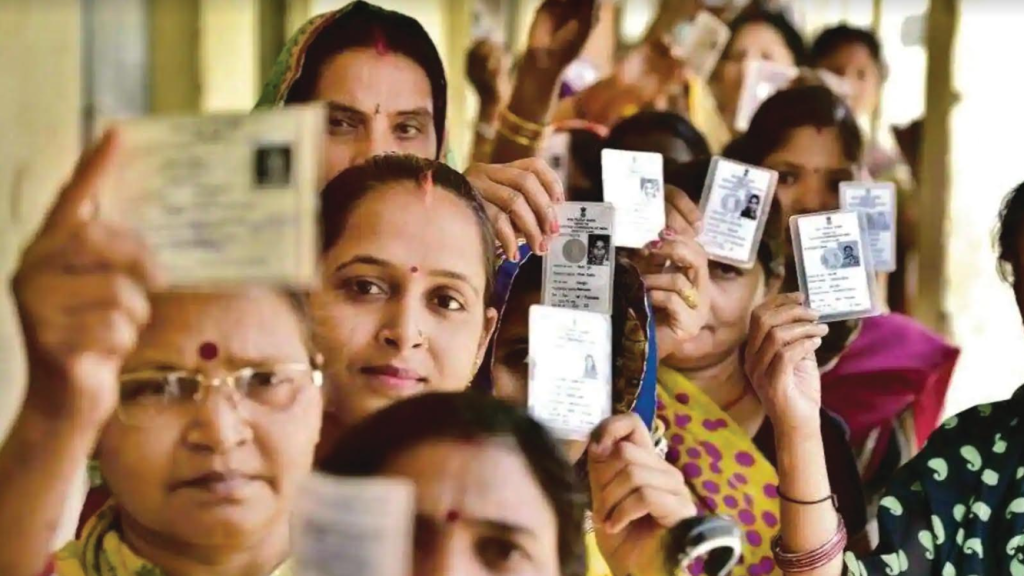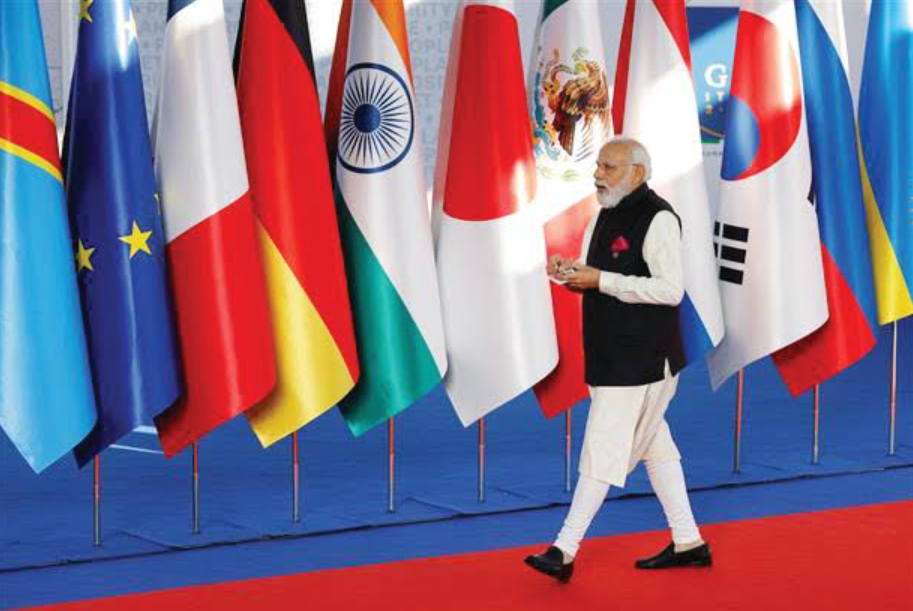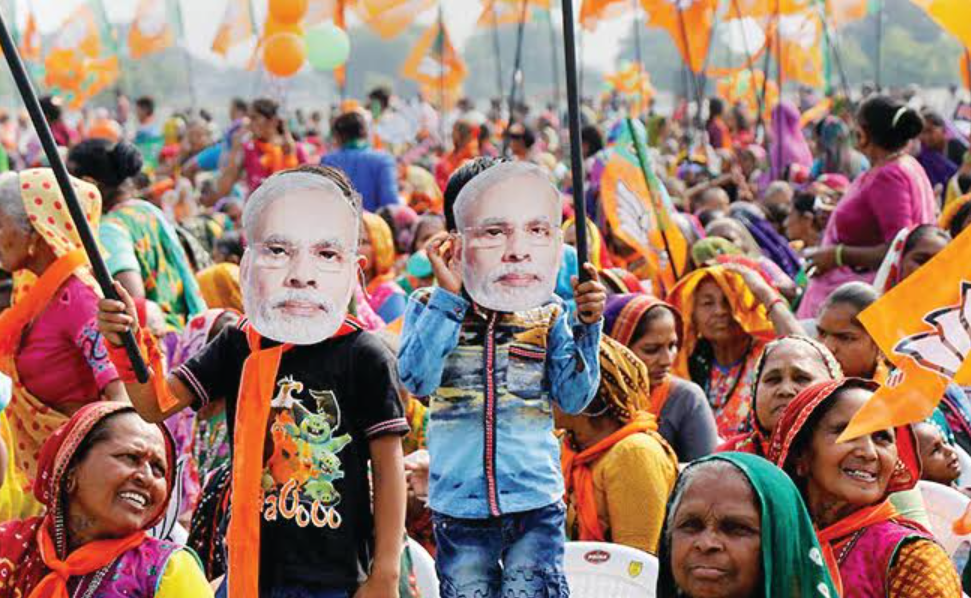India has embarked on a year of elections ahead of the general election in 2024. In spite of the cliché, 2023 is undoubtedly the semi-final year since the Lok Sabha elections are due before the middle of 2024. Hence from coining a ‘One Nation One Election’ slogan, would it persuade the Modi govt to opt for early polls?
By Shailendra Kumar
- The official cost of holding general elections alone has skyrocketed close to Rs 5000 Crore in 2019 from close to Rs 11 Crore in 1952 per voter
- Notwithstanding the tsunami of digitalisation forces, India’s shadow economy, which suffered a smackdown is back to its adulthood
- The political heavyweights began to put to use some of the constitutional powers under Article 356 to realise their narrow political gains
- Political planks for the Centre can be linked to the local or regional planks, the voters can be educated to make a distinction and exercise their franchise
If dissent is the soul of democracy, elections are truly the heart. The only whale problem, unfortunately chronically, with this ‘heart’ is – it is put through a surfeit of pumping in India. Going by the taxonomy, there are multiple layers of elected public representatives and since political parties nowadays inject no less intensity of vims and vigour even in municipal and panchayat polls, it tends to showboat often the hackneyed art of political skulduggery, chicanery and subterfuge which go on weakening the social fabrics in the country. Voila, a febrile rise in social fissility.
India has a multi-party system unlike the democracy in the rich world, and it tends to heat up the mercury which often spills over into vandalism, social and communal tensions and also naked violence. It becomes more acutely perilous where joblessness is more severe as compared to the national average and the young tend to see politics as the most lucrative or loot-worthy vocation. Besides the steep socio-political costs, the continuity in the rhythm of holding frequent elections inevitably bites into the quality of the governance matrix and certainty of development projects marred by cost overruns. It necessarily costs eye-wateringly high public expenditure. Often looks unaffordable for a poor country like India. Let’s get the low-down on poll expenses.
WHOPPING EXPENDITURE
The official cost of holding general elections alone has skyrocketed close to Rs 5000 Crore in 2019 from close to Rs 11 Crore in 1952, per voter expenditure has jumped from 6 paise in 1952 to Rs 51 per voter in 2019. If we look beyond the official datasets, a whopping sum of USD 7 billion (Rs 55000 Crore) was spent in 2019 as per multiple studies. A haunting jump of 40 percent as compared to 2014 data. Mostly on social media, logistics, electioneering materials and also cash and freebies distributed to suborn voters. As per data, only American democracy spent more – a tad higher than USD 14 bn in 2020. But it was only USD 5 bn in 2016.
During the biggest carnival of democracy, India spent USD 8 per voter against USD 3 which 60 percent of its population earns per day for its living. If we add the official and unofficial expenses of state and local elections conducted during a period of five years, even the highest peak on the Himalayas would pale in awe against the mounds of money spent. The Election Commission of India had, during the 2019 polls, seized liquor, drugs and cash worth Rs 3500 Crores. If we apply the doctrine of stare decisis, the most successful seizure records of any goods or currency worldwide (even in the case of Customs) range between 7 to 10 per cent. Going by the extrapolative method, the sum which may have escaped the claws of the Election Commission would have been multiple times – perhaps, beyond estimation. Such projected statistics perhaps prompted the ECI to admit before the Supreme Court of India recently, the growing use of money in elections notwithstanding its stringent monitoring of permissible poll expenses.
Interestingly, it was historically not the scenario till 1967 when the general elections and state elections were perfectly synchronised – once in five years. Yup, a joyous cacophony of electioneering – voting was seen as a civil sacrament. But the healthy convention began wilting with the political machinations fuelling pharaonic ambitions imbued with totalitarian tendencies. The political heavyweights frequently began to put to use some of the constitutional powers under Article 356 to realise their narrow political gains. The first victim of such a monumentally flawed and controversial trend was the harmony in the poll-holding cycle. State elections were held at different points of time after the revocation of the President’s Rule.
ONE NATION, ONE ELECTION
The distortions in the body of Indian polity multiplied mucho and their ripple effect injected a fresh bout of annual rhythm in the schedule of elections in the country. In this backdrop, the Prime Minister, Narendra Modi, coined a new mission – One Nation One Election.

A whopping sum of USD 7 billion (Rs 55000 Crore) was spent in 2019 as per multiple studies. A haunting jump of 40 percent as compared to 2014 data. Mostly on social media, logistics, electioneering materials and also cash and freebies distributed to suborn voters. As per data, only American democracy spent more – a tad higher than USD 14 bn in 2020. But it was only USD 5 bn in 2016
His idea is to put a common floor beneath the cycle of elections. Though his intent is to restore the lost tradition of synchronised polls for the Centre and the States, but, his political bête noires have sworn to misread his ideas and dub them as misbegotten remedies. Even though the Law Commission also wrote to all regional and national parties to share their legitimate concerns so that a healthy debate could be initiated countrywide, but, most political parties failed to clothe their differences with merit-laced meats. The gist of the debate by the opposition parties is – they failed to take the gilt off the gingerbread.
Although not much headway was made on this issue, but here comes a history-bending opportunity for the Prime Minister to translate his idea into action. How? As many as five States are due for polls in the month of December and January 2024 – Mizoram, Chhattisgarh, Madhya Pradesh, Rajasthan and Telangana. The general elections for electing the Central Government are also going to be due in April 2024. If the Prime Minister really meant more than the coinage of a slogan, he can convince his party to advance the general elections by a few months and let there be a synchronised holding of elections for the Centre as well as the States. This would enormously reduce the burden on the Election Commission, government officials of the Centre and the States involved in such a colossal exercise; logistics costs; deployment of paramilitary forces and the public expenditure incurred by the ECI. In addition, it would also reduce the poll-related raining of cash, liquor and drugs besides genuine expenses of the political parties such as advertising, travel, lodging, food etc.
To a large extent, the political leaders of the Centre as well as the States would also save on time, energy, promises of freebies and political planks needed to win over the voters. No need to generate two different tides for the general elections and the State poll. Good for the voters, indeed! Political planks for the Centre can be linked to the local or regional planks, the voters can be educated to make a distinction and exercise their franchise. In my view, the Centre should speak to some of the States whose elections are due in June 2024. If any State government ruled by a different political party sees merit in its slogan and is also confident of its performance, one may respond to the call for synchronised polls in January.
A politician generally thinks of the next election but a statesman, of the next generation. And Modi is globally perceived as the one who not only talks about Amrit Kaal but also believes in action as and when needed. If this is so, he should grab this opportunity to mend the stained trend and help keep the focus of the government machinery on the all-around development of the nation rather than regularly-held polls. Since preparations for elections, in either case, roll out almost a year in advance, the pivotal decision-making in the policy domain, debatably, loses momentum and regains the same only after a new government is sworn in. A major hiatus is created in the ring of governance and development. Secondly, it would also militate against what political pundits generally call the institutionalisation of corruption during polls.
Scientists say that cash inducements and other types of freebies, regularly showered or promised during frequent polls, tend to get rooted in the neurons of voters. Synchronisation of polls would snap off such a thread which tends to nourish the parallel economy in the country. Notwithstanding the tsunami of digitalisation forces, India’s shadow economy which suffered a smackdown during demonetisation is back to its adulthood. And frequent elections are one of the pillars of the black economy. Apart from lending a halo of meaningful credence to his ‘One Nation One Election Slogan’, what else may persuade PM Modi, to go for early polls?
The opposition parties are, at present, a sundered community of directionless groups. They are busy with the intaxicating flavours of their dog-whistle politics. Even the hoary Congress Party today looks like a big fish in small ponds – stewing in grievance out of office. Their efforts to come under one umbrella and hitchhike on one another have thus far been a bumbling failure.
PM Modi’s spine-stiffening poll announcement may not only snag them on the wrong foot but also wreck the clock needed to forge a cohesive group or cobble together a unified opposition. A few faint and meek voices of unity may be heard today from some wild nooks but this would also vanish into the stratosphere once the entourage-heavy BJP poll chariots chug on the electioneering highways. A sure-shot decision to up the stress hormone cortisol in the big-tent parties.

During the G20 Summit, global attention will measurably rain on India and copious benefits being reaped in the geopolitical domain. For any political party, translating such laurels into votes is a hugely desirable wish. So, general elections in January would enable the BJP to cash in on the global coverage and the media hype generated in early September
Yet another kosher reason for such a move could be an effort to capitalize on the much-publicised G-20 presidency of India. None, even in the Opposition, can deny that Prime Minister Modi has earned mucho laurels for India by succeeding in his efforts to bring G-20 Summit, for the first time, in India in September 2023. Global attention is measurably raining on India and copious benefits are being reaped in the geopolitical domain. For any political party, translating such laurels into votes is a hugely desirable wish. So, general elections in January would enable the BJP to cash in on the global coverage and the media hype generated in early September during its poll campaigns for a few months.
Linked to the G-20 presidency are the indefatigable efforts of the MEA and S Jaishankar to impress upon Putin to halt the war in Ukraine as it has not only pulverised a major part of the global supply chain but also tamped down millions of people in the blackhole of poverty in low-income countries. Many Asian and African economies have suffered serious setbacks and are now on the cusp of debt default like Sri Lanka and Pakistan. Since India has increased its diplomatic heft in the past few years, MEA is legitimately toiling hard for a breakthrough in the Ukraine war.
SAILING THROUGH ECONOMIC
STORIES IN THE ELECTIONS
If the general elections are advanced, the BJP poll campaigners can reel out many caffeinated stories for the voters. This would also reduce the crapshoot elements or the vagaries of the global energy prices. Let’s not forget that India imports close to 85% of its energy needs which costs a major swathe of its forex kitty

The year 2023 is lumbered with the vestigial problems of the pandemic such as walloped global supply chains and the devastating consequences of the Ukraine War in terms of high priced energy and commodities worldwide. The twin destabilising forces have roiled the life of billions of people and upended the economic growth trajectories in the rich as well as low-income nations. Worse, their combined offspring, inflation, has come as a long-term pestering economic ill. It has elbowed almost 50% of the global economy towards the edge of recession. In this backdrop, India remains a brightly twinkling star in the economic firmament. With over 6 per cent growth in the fiscal year 2023-24, India is being globally acknowledged as an island of growth and the magnet for FDI. To sustain the growth, the Modi Government has allocated an enormous chunk of resources – over Rs 10 lakh crore, for capital expenditure. If the defence allocation is also added, the total sum would swell up to Rs 13 lakh crore. Besides pumping in huge resources in the infrastructure sector, the Union Budget 2023 has also succeeded in creating a savoury optics for the individual taxpayers.
The glimmer of good economic news needs to be capitalised on or translated into votes. If the general elections are advanced, the BJP poll campaigners can reel out many caffeinated stories for the voters. This would also reduce the crapshoot elements or the vagaries of the global energy prices. Let’s not forget that India imports close to 85% of its energy needs which costs a major swathe of its forex kitty. The petroleum prices are generally volatile which may zoom up if the Chinese economy opens up fully and regains its momentum. As soon as the demand curve for crude and gas soars up, the crude prices would further go up. What may further elbow it upwardly are the possibilities of the Ukraine War folding up in the coming months if a truce is negotiated. This would enable Russia to join the crude cartel. There are live chances that the crude prices may shoot up beyond USD 100 per barrel in the coming months and that would be nightmarish for India. The Modi Government would not be able to avoid raising taxes and any hike in diesel and petrol prices would certainly be exploited by the Opposition parties which would miss even long-shot chances to eat BJP’s lunch. Therefore, political sagacity for the PM Modi would be to avoid such a risk and weave saleable stories about the Indian economy and the generation of millions of jobs vide the infrastructure projects and the PLI-assisted ‘Make in India’ schemes. Economic stories indeed sell well during polls, and they should always be a part of political reckoning.
